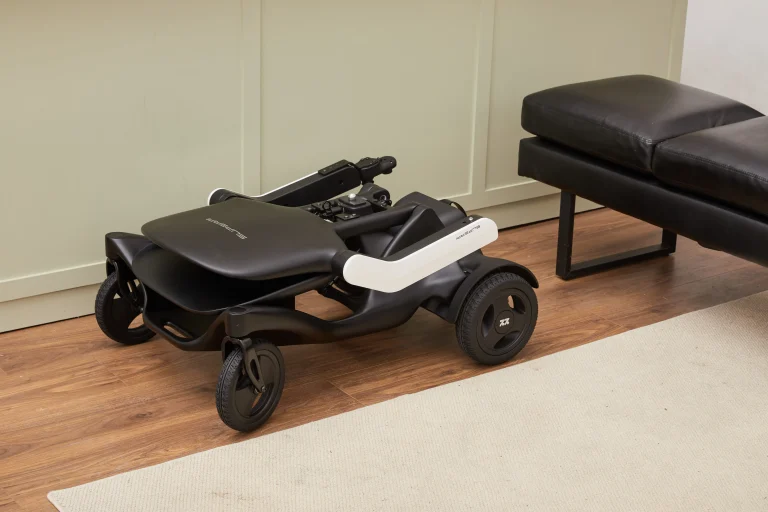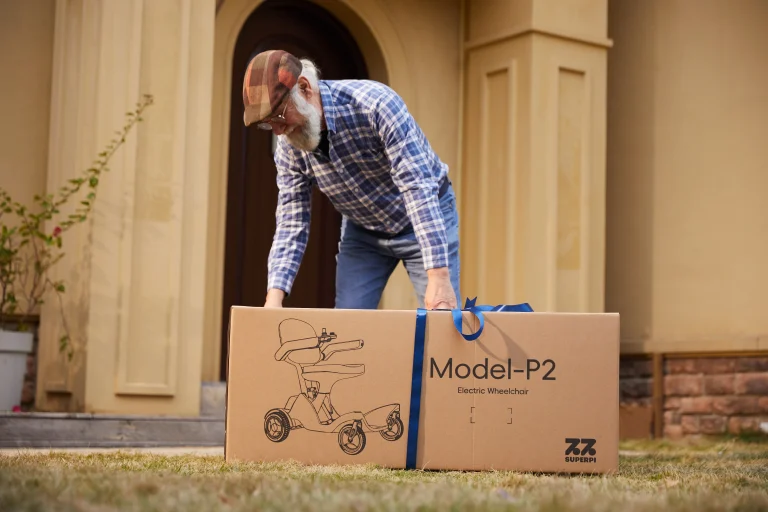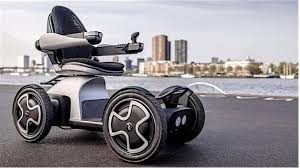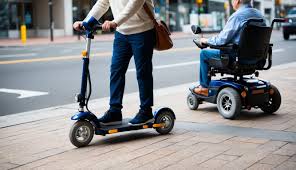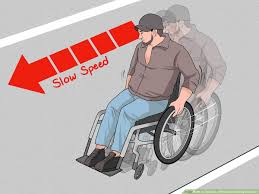
År 2023 fångade en viral Dashcam-video en power rullstolsanvändare i Seattle som gled okontrollerat ner en regnslickad kulle in i ett kafés uteserveringsområde. Medan ingen skadades utlöste händelsen en kritisk konversation: över 71% av rullstolsrelaterade olyckor förekommer på våta ytorEnligt CDC. Oavsett om det navigerar i regnblöt trottoarer, isiga parkeringsplatser eller nymoppade golv, handlar det inte bara om rörlighet-det handlar om att återkräva ditt oberoende inför fysik-bränsle faror.
Den här guiden blandar hydrodynamik, materialvetenskap och verkliga hacks. Du kommer att lära dig hur däckslitningsmönster kanaliserar vatten, varför silikontillsatser överträffar salt för istraktion och hur NASA-inspirerad terrängskanningsteknik kan förhindra katastrofer. Från DIY anti-hydroplaning-mods till manövrer av nödsituationer kommer vi att förvandla din rullstol till en våt-väderkrigare.
1. Våt ytfysik: Varför saker går fel
1.1 Hydroplaning -ekvationen
- Kritiska faktorer:
- Vattenfilmtjocklek: Hydroplaning börjar vid 1 /10” (2,5 mm) djup.
- Hastighetströskel:�ℎ� = 10,35 × � × �Vhp=10.35×p×μDär �p = däcktryck (psi), �μ = friktionskoefficient.
- Exempel: Vid 30 psi och μ = 0,3 (våt asfalt) börjar hydroplaning vid 9,2 mph.
1.2 Ice & Black Ice Dynamics
- Friktionskoefficientvariabilitet:
- Dry Ice: μ = 0,15
- Våt is: μ = 0,08 (nästan friktionslös)
- Viktfördelning: 55% bakre belastning maximerar dragkraften för RWD -stolar.
Fallstudie: En Permobil F5-användare undviks katastrof genom att byta till 4-hjulsdriftläge på svart is-ett drag som minskade slipen med 83% (University of Michigan, 2023).
2. Däckteknologi: Din våtytans livlinje
2.1 slitbanemönster för vatten evakuering
- Kanaldesign:
- Riktningsledbanor (t.ex. Schwalbe Marathon Winter): V-formade spår tryck vatten utåt.
- Sipare: Mikro-spår (0,5 mm bred) Skapa sug på våt betong.
- Trampdjup: Byt ut däck om under 3 /16” (4,7 mm) —Shallow slitbanor ökar hydroplaneringsrisken med 65%.
Testa: Häll 1 liter vatten på trottoar - bra däck bör rensa en 12 ”stig på 2 sekunder.
2.2 Vinterdäckhack
- Skruvläge:
- #6 plåtskruvar (1 /2” lång): Infoga 20–24 per däck för isgrepp.
- Mönster: Koncentriska cirklar på yttre slitbanor.
- Flytande dragkraft:
- Silikonspray: Applicera på slitbanor var 8: e timme (varar längre än salt).
- 70% isopropylalkohol: sänker vattnet fryspunkt (-20 ° F /-29°C).
Pro tips: Använd en uppvärmd däckfilt ($ 45) för att förhindra isuppbyggnad över natten.
3. Styrsystemjusteringar
3.1 Programmering av våtläge
- Hastighetsbegränsande: Cap -hastighet vid 60% av max (t.ex. 3,6 mph för 6 mph stolar).
- Vridmoment ramp-up: Ställ in accelerationsfördröjning till 1,5–2 sekunder för att förhindra hjulspin.
- Regenbromsning: Öka till 80% styrka för jämnare stopp.
Tillverkarinställningar:
- Pride Mobility: “Rain Mode” (Joystick -knapp + ▼ i 3 sekunder).
- Quantum Rehab: Anpassningsbar via Q-Logic 3-programvara.
3.2 TC -system (TC)
- Hur det fungerar:
- Halleffektsensorer upptäcker hjulslip.
- Controller minskar kraften till att glida hjulet.
- Omdirigerar vridmoment till jordat hjul.
- Eftermarknadssatser:
- TRAK-PLUS TC-modul ($ 420): Lägger till slipkorrigering till icke-TC-stolar.
4. Viktfördelning och stabilitetshack
4.1 Sänkande tyngdpunkt (COG)
- Säte modifieringar:
- Släpp sitthöjd med 2 ”(minskar kuggen med 18%).
- Installera vikter under-sätet (blyplattor i nylonpåsar, max 8 kg totalt).
- Batterilistan:
- Flytta bakre batterier framåt 4–6 ”för FWD -stolar.
Varning: Undvik att hänga påsar på pushhandtag - dra nytta av kugge farligt.
4.2 Spårbreddutvidgning
- Bult-on-förlängare:
- Aluminiumavstånd breddar hjulbas med 3–4 ”(kontrollera lokala breddregler).
- DIY -alternativ: Fäst PVC -rör fyllda med sand till axlar.
- Utrigghjul:
- Installera 4 ”diameter polyuretanrullar på svängarmar (förhindrar sidoskivor).
5. Avancerade navigationstekniker
5.1 "Creep Method" för is
- Ställ in hastigheten till 1–1,5 mph.
- Flytta joystick i ½ ”pulser (efterliknar ABS -bromsning).
- Håll hjulen raka - vändningar minskar dragkraften med 40%.
Borra: Öva på en våt plast tarp strö med skåltvål.
5.2 Crossing Metal Grates & Pavement Markings
- Vinklad tillvägagångssätt: Korsmålade linjer vid 45 ° för att minimera glidningen.
- Dynamisk viktförskjutning: Luta dig något framåt när man korsar metallytor.
Farozoner:
- Manhålskydd: 300% mer hala när det är vått (μ = 0,05).
- Zebra -korsningar: Termoplastisk färg blir slicker än is i regn.
6. Akutprotokoll
6.1 framhjulsspelet återhämtning
- Styr in i bilden (motintuitiv men kritisk).
- Skift vikt bakåt (tryck på axlarna i sätet).
- Applicera mild omvänd kraft när den är inriktad.
6.2 Återåterhämtning
- Styra bort från bilden.
- Skift vikt framåt (mager överkropp över knän).
- Fjäder framåt kraft för att återfå dragkraft.
Överlevnadssats:
- Vikbara dragmattor (t.ex. Safe-T-Mat).
- 12V uppvärmda grepp för joystick (förhindrar dumma fingrar).
7. Förebyggande underhåll för våta förhållanden
7.1 Dagliga kontroller
- Däckinspektion:
- Ta bort inbäddat glas /pebbles med nål-nos tång.
- Test slitbanflexibilitet -Styva däck (under -10 ° C) förlorar 90% grepp.
- Motorsäl:
- Kontrollera IP -betyg (IP54 -minimum för våta miljöer).
- Spraya silikon på exponerade kontakter.
7.2 Månadsuppgraderingar
- Uppgraderingslager: Rostfritt stål eller keramiska lager motstår rost.
- Impregnering:
- Applicera konform beläggning på Controller PCB (mg kemikalier 422b).
- Använd fett från marin klass på pivotpunkter.
8. Väderspecifika strategier
8.1 Tungt regnprotokoll
- Synlighet:
- Fäst 200-lumen LED-remsor till armstöd (USB-laddningsbara).
- Använd regnponcho med hög synlighet med reflekterande remsor.
- Dräneringsvägar:
- Karta trottoarer med> 2% lutning med appar som Wheelmap.
8.2 Snö- och is taktik
- Däckkedjor:
- V-bar dragkedjor (storlek 25x8x12) passar de flesta 8 ”hjul.
- Installera /remove på 3 minuter med spännare.
- Förbehandling:
- Spraydäck med betesaftlösning (sänker ishäftning med 70%).
9. Juridiska och försäkringsöverväganden
- Modifieringslagar:
- Däckspikar /chains kan bryta mot kommunala förordningar (kontrollera lokala koder).
- Ansvar:
- Skador av egendom från bilder kan nekas om styrenheter saknar fabrikscertifierade våta lägen.
10. Framtida innovationer
10.1 Smarta däck
- Goodyear hydrogrip:
- Mikropumpar suger aktivt vatten från kontaktlappar.
- Självhelande gummitätningar (patent pågående, 2025 frisläppande).
10.2 Ytskanning AI
- Intel RealSense Lidar:
- Detekterar slickfläckar 15 fot framåt, autojusterande hastighet /torque.
- Varningar via joystickvibration (haptisk feedback).
Slutsats
Att navigera i våta ytor i en rullstol handlar inte om att undvika regnet - det handlar om att konstruera dig igenom det. Genom att kombinera däckvetenskap, intelligenta viktskift och förutsägbara körvanor kommer du att förvandla slick trottoar från ett hot till en erövbar utmaning. Kom ihåg: Varje droppe under dina hjul är inte bara vatten ... det är en annan möjlighet att trotsa begränsningarna.
11. BILAGA: Snabbreferensguider
Draglösningar efter yttyp
| Yta | Däcktrycket | Hastighetsbegränsning | Draghjälpmedel |
|---|---|---|---|
| Våt asfalt | 30 psi | 4 mph | Riktningsledbanor |
| Halt | 25 psi | 1 km / h | Skruvspikar |
| Snötäckt gräs | 20 psi | 2 km / h | Däckkedjor |
| Oljiga parkeringsplatser | 35 psi | 3 mph | Silikonspray |
Akutkontakter
- 24 /7 vägassistans: [Lokala mobilitetstjänster]
- ADA HOTLINE: 1-800-514-0301
Uppmaning:
Dela din slickaste överlevnadshistoria nedan! Topp 3 poster vinner gratis däckuppgraderingar av alla väder Från WetGrip -rörlighet.

